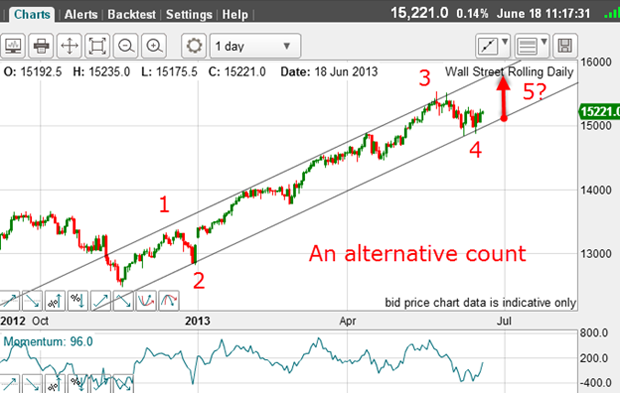US Federal Reserve – the markets are all ears
The world's central banks are now the market, says John C Burford. So far, they have been the buyers. But will they turn into forced sellers at some point?
The big day has arrived.
At 7.30pm BST, Ben Bernanke will speak and the whole world will be all ears, hanging on his every word. It's almost biblical!
But why does he have so much dominant power over the markets? And why are markets so dependent on what he says and does?
MoneyWeek
Subscribe to MoneyWeek today and get your first six magazine issues absolutely FREE

Sign up to Money Morning
Don't miss the latest investment and personal finances news, market analysis, plus money-saving tips with our free twice-daily newsletter
Don't miss the latest investment and personal finances news, market analysis, plus money-saving tips with our free twice-daily newsletter
Consider this: The Fed is buying $1.8trn of AAA bonds each year out of an available market of $2trn. This is totally unprecedented.
Then, the world's major central banks who regularly collude - now own $20trn in bonds, equal to around 25% of global GDP.
The fact is central banks are now the market! So far they have been the buyers, but will they turn into forced sellers at some point?
What they say and do have always had an impact on markets, but today it is even more so.
I certainly would not want to be in Bernanke's shoes. The whole weight of the financial world is on his shoulders and he knows it!
But we all know that this central bank propping up of markets cannot go on forever, and this is why investors/traders have been busy positioning themselves for what they hope is the correct interpretation of his words.
And the longer this game goes on, the harder it will be for the Fed to engineer a soft landing'.
But the pressure is on to begin starting to announce a plan to try to tip-toe out of quantitative easing (QE) long-term bond yields are already strengthening, contrary to the Fed's intentions (or hopes).
As a trader, I try to ignore my own views in this case, I am open and focused on what the others are doing.
The swinging COT data
From this and other sentiment data, it is clear that the small traders/investors have been buying equities with abandon.
Remember, this is classic topping behaviour, especially coming after a strong four-year rally.
Now here is the data for the $5 Dow:
| ($5 X DJIA INDEX) | Row 0 - Cell 1 | Row 0 - Cell 2 | Row 0 - Cell 3 | Open interest: 110,852 | ||||
| Commitments | ||||||||
| 45,533 | 5,485 | 141 | 47,755 | 86,549 | 93,429 | 92,175 | 17,423 | 18,677 |
| Changes from 06/04/13 (Change in open interest: -5,289) | ||||||||
| -3,240 | 120 | 5 | -958 | -3,213 | -4,193 | -3,088 | -1,096 | -2,201 |
| Percent of open in terest for each category of traders | ||||||||
| 41.1 | 4.9 | 0.1 | 43.1 | 78.1 | 84.3 | 83.2 | 15.7 | 16.8 |
| Number of traders in each category (Total traders: 97) | ||||||||
| 30 | 15 | 4 | 34 | 29 | 66 | 46 | Row 8 - Cell 7 | Row 8 - Cell 8 |
This data is telling me that the consensus believes that the Fed will make no substantive changes to the QE programme. What I think doesn't matter.But with the long side as overcrowded with specs as it is, there is scant room for error.
Bubble tops are too tricky to call
But here is an equally attractive alternative labelling:

The 22 May high is now my wave 3 top, the decline this month is a new wave 4, and we can expect a new high for wave 5 under this labelling.
This actually looks better, as my new wave 3 has a clear five-wave pattern within, whereas the old wave 3 did not have such a clear pattern.
Now, I can draw a new tramline pair, with my upper line having good touch-points.
With markets and Elliott wave labels we are dealing with probabilities, not certainties.
The bottom line is this: As a coward, my policy is to sit this one out, as bubble tops are notoriously tricky to judge and the top may be my new wave 5 which lies above 15,540. We shall see.
Get the latest financial news, insights and expert analysis from our award-winning MoneyWeek team, to help you understand what really matters when it comes to your finances.
John is is a British-born lapsed PhD physicist, who previously worked for Nasa on the Mars exploration team. He is a former commodity trading advisor with the US Commodities Futures Trading Commission, and worked in a boutique futures house in California in the 1980s.
He was a partner in one of the first futures newsletter advisory services, based in Washington DC, specialising in pork bellies and currencies. John is primarily a chart-reading trader, having cut his trading teeth in the days before PCs.
As well as his work in the financial world, he has launched, run and sold several 'real' businesses producing 'real' products.
-
 Football fans issued warning over ticket scams ahead of 2026 World Cup
Football fans issued warning over ticket scams ahead of 2026 World CupSantander customers lost more to football scams in the first six months of 2025 compared to the same period in 2024, when total losses surged due to the Euros
-
 Nationwide fined £44 million over “inadequate” anti-money laundering systems
Nationwide fined £44 million over “inadequate” anti-money laundering systemsFailings in Nationwide’s financial crime processes between October 2016 to July 2021 meant one criminal was able to deposit £26 million from fraudulent Covid furlough payments in just eight days.